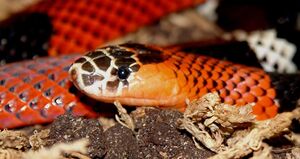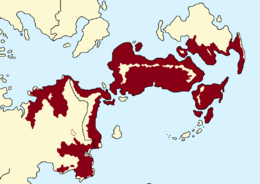Micrurus rexanguis: Difference between revisions
ContraViper (talk | contribs) |
ContraViper (talk | contribs) No edit summary |
||
| (7 intermediate revisions by the same user not shown) | |||
| Line 1: | Line 1: | ||
{{Taxobox | {{Taxobox | ||
| name = King Coralsnake | | name = King Coralsnake | ||
| status = LC | | status = LC | ||
| status_system = IUCN3.1 | | status_system = IUCN3.1 | ||
| extinct = | | extinct = | ||
| image = Inyur_coralsnake02.jpg | | image = Inyur_coralsnake02.jpg | ||
| image_width = 300px | | image_width = 300px | ||
| image_caption = Micrurus rexanguis | | image_caption = Micrurus rexanguis | ||
| regnum = Animalia | | regnum = Animalia | ||
| phylum = Chordata | | phylum = Chordata | ||
| classis = Reptilia | | classis = Reptilia | ||
| ordo = Squamata | | ordo = Squamata | ||
| familia = Elapidae | | familia = Elapidae | ||
| genus = Micrurus | | genus = Micrurus | ||
| species = ''M. rexanguis'' | | species = ''M. rexanguis'' | ||
| binomial = Micrurus rexanguis | | binomial = Micrurus rexanguis | ||
| binomial_authority = | | binomial_authority = De la Cruz, 1813 | ||
| range_map= Mrexanguis range.png | | range_map = Mrexanguis range.png | ||
| range_map_width = 260px | | range_map_width = 260px | ||
| range_map_caption= Range of ''M. rexanguis'' | | range_map_caption = Range of ''M. rexanguis'' | ||
}} | }} | ||
'''''Micrurus rexanguis''''', common name: '''King Coralsnake''' also known as the '''Elapidé Grande''' in [[Inyurstan]], is a large species of venomous elapid snake found in a variety of habitats across Inyursta and Cuscatlan. | '''''Micrurus rexanguis''''', common name: '''King Coralsnake''' also known as the '''Elapidé Grande''' in [[Inyurstan]], is a large species of venomous elapid snake found in a variety of habitats across Inyursta and Cuscatlan. This species is one of the largest venomous snakes in Inyursta, and reputed for its diet consisting mostly of other snakes. | ||
==Habitat== | ==Habitat== | ||
| Line 42: | Line 42: | ||
Its venom is designed for quick paralysis of reptilian targets. In humans, it can cause respiratory distress, loss of motor skills and use of extremities, and nerve damage if left untreated. | Its venom is designed for quick paralysis of reptilian targets. In humans, it can cause respiratory distress, loss of motor skills and use of extremities, and nerve damage if left untreated. | ||
==Description== | ==Description== | ||
[[File:Inyur kingcoral 02|thumb|Juvenile Micrurus rexanguis from Marindino Centrele]] | [[File:Inyur kingcoral 02.jpeg|350px|thumb|left|Juvenile Micrurus rexanguis from Marindino Centrele]] | ||
[[Category:Inyursta]], [[Category:Inyurstan Wildlife]] | The King Coralsnake is the largest elapid snake in Inyursta, with adults averaging approximately 130cm total length - though average species size is closer to 76cm due to the age-class pyramid favoring densities of juveniles and subadults. Record length is 2.27m female. Like other coralsnakes, females are typically larger than males, though in M. rexanguis females only average approximately 9-13% longer and 5-8% greater body mass. | ||
Average head width is one of the largest of any coralsnake, with head widths at adult age measuring 20-22% wider than the widest part of the body. | |||
An easily recognizable species, the King Coralsnake has a red body with two white or light-cream bands side-by-side anchored by thicker black bands. It's neck is red, with a black eye on a red face, and the black color typically seen on other coralsnakes is only present on the upper front of the face. Scales on the red and gold bands have black-pigmented tips at the end, creating a gentle speckling across the otherwise light parts of the body. | |||
[[Category:Inyursta]] | |||
,[[Category:Inyurstan Wildlife]] | |||
Latest revision as of 18:48, 30 April 2024
| King Coralsnake | |
|---|---|

| |
| Micrurus rexanguis | |
| Scientific classification | |
| Kingdom: | Animalia
|
| Phylum: | Chordata
|
| Class: | Reptilia
|
| Order: | Squamata
|
| Family: | Elapidae
|
| Genus: | Micrurus
|
| Species: | M. rexanguis
|
| Binomial name | |
| Micrurus rexanguis De la Cruz, 1813
| |

| |
| Range of M. rexanguis | |
Micrurus rexanguis, common name: King Coralsnake also known as the Elapidé Grande in Inyurstan, is a large species of venomous elapid snake found in a variety of habitats across Inyursta and Cuscatlan. This species is one of the largest venomous snakes in Inyursta, and reputed for its diet consisting mostly of other snakes.
Habitat
Overall, the King coralsnake can be considered a habitat generalist that occupies a wide variety of forested, savanna and grassland habitats and shows little selection for soil types. Rainforests, coastal dry forest, tropical savannas, submontane forest, submontane prairie and post-agricultural pastures are all frequently occupied by M. rexanguis. However, it is absent from high-altitude habitats, and further into Cuscatlan it becomes rare at the edge of its range into flooded river basin forests.
Temperature selection is believed to play a larger role than vegetative community, moisture or soil type. It is not found in arid/semi-arid regions where daytime temps commonly exceed >38oC/100oF, and subtropical regions where cold-season nighttime temps drop below 6oC/42oF.
Life History
This species is primarily nocturnal and crepuscular, with activity at lower elevations typically peaking between 30 minutes before sunset through 5 hours after sunset. A separate study found that activity in a submontane population peaked at 2 hours before sunset to 2.5 hours after sunset.
Diet
The King Coralsnake is a prolific predator of other snakes. It does not appear to favor any particular taxonomic group of snakes, though by proportion of abundance it appears viperids are less frequently targeted. Common prey includes Coffee snakes, Inyurstan rat snakes, and sp here... Studies have found that they have some resistance to the venom of other coralsnakes, though not complete immunity.
Reproduction
Breeding occurs April - early June, though may occur sooner in the more stable tropical climates breeding may extend January - August (though frequency still peaking in April & May). Egg-laying season is August-September across their range. Females may lay between 18-36 eggs in a single clutch, and larger more mature females may lay up to two clutches per season. Marcieno et al., 2016, reported that the "second clutch" is always smaller than the first, usually 50-70% the quantity of eggs as the first. A minimum "second clutch" size was reported at just 9 eggs.
Eggs hatch in 2-3 weeks. No maternal attendance is recorded.
Venom
The venom of this species is comprised of primarily of Long-Chain Neurotoxins (LCNs) and Phosopholipase-A2's (PLA2's). Effects are primarily pre-synaptic neurotoxic, with some cases of post-synaptic neurotoxic effects. Minor cytotoxic tissue damage is also reported as a minority effect.
Its venom is designed for quick paralysis of reptilian targets. In humans, it can cause respiratory distress, loss of motor skills and use of extremities, and nerve damage if left untreated.
Description
The King Coralsnake is the largest elapid snake in Inyursta, with adults averaging approximately 130cm total length - though average species size is closer to 76cm due to the age-class pyramid favoring densities of juveniles and subadults. Record length is 2.27m female. Like other coralsnakes, females are typically larger than males, though in M. rexanguis females only average approximately 9-13% longer and 5-8% greater body mass. Average head width is one of the largest of any coralsnake, with head widths at adult age measuring 20-22% wider than the widest part of the body.
An easily recognizable species, the King Coralsnake has a red body with two white or light-cream bands side-by-side anchored by thicker black bands. It's neck is red, with a black eye on a red face, and the black color typically seen on other coralsnakes is only present on the upper front of the face. Scales on the red and gold bands have black-pigmented tips at the end, creating a gentle speckling across the otherwise light parts of the body. ,
